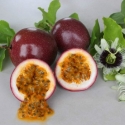BACK
Growing Passion Fruit
Eat raw, drink the juice, drizzle on a pav, and there’s nothing quite like a passionfruit icing to up-flavour a sponge or madeira cake.
Passion Fruit is a native of South America, the vines are one of the most bountiful home-grown fruits. Passion fruit has a highly-scented, sweet fruit which is eaten, pulp and seeds, direct from shell, and they’re abundant with goodness – high in Vitamin A and C, antioxidants and minerals.

Situation - Passionfruit vines thrive best in subtropical and temperate regions but will adapt to other areas if they’re protected from frosts. Choose a sunny, frost-free spot and lavish your passionfruit plant with care and attention. The vine needs room to climb - one passionfruit can grow to 5m high x 3m wide or more when happy in its environment.
Planting - Spring to autumn is the best time to get started with planting a new vine or to give one that’s already growing a helping hand. Ideal spots would be along a wire fence, across a balcony, or over a pergola, where they provide year-round shade. If you want to grow a vine along a sunny wall or fence, support its growth by giving it something to climb on.
Prepare the area and apply well-rooted compost or animal manual – dig in well. Plant the root ball only as deep into the soil, as it was in the pot, and water well. Passionfruit vines develop extensive root systems and don’t do well if competing with other plants, including weeds and grass!
It can take 12–18 months for a newly planted vine to reach fruiting size, although some flowers may be produced in its first summer or early autumn.
Water - Passionfruit are very thirsty and need regular watering once the plant is established and when the flowers and fruit are forming.
Feeding - When feeding your passionfruit, consider their roots and spread fertiliser and mulch widely, not just around the base of the stem. Apply fertiliser in spring and then every four weeks through summer. Always water in fertiliser.
Pruning - You don’t need to prune your passionfruit; however, this can be done to encourage new growth, ensure sunlight filters through the vine to the fruit for ripening, or to stop the vine becoming excessively tangled. If pruning, its best done in springtime, before flowering and be careful not to remove major branches.
Handy Tip – Passionfruit all year round! Pulp and seeds can be preserved by freezing into ice cube trays – when frozen, release from trays, put frozen cubes of pulp into plastic bags / containers, keep in freezer until required
Also see Passion Fruit Pulp Preserved
For Passion Fruit, we recommend:
- Pelletised sheep and chicken manure
- Slow Release Citrus Food
- Bio Fungicide
BACK
HL Nurseries Limited t/a Wairere Nursery
826 Gordonton Road, R D 1, Hamilton 3281 Ph: (07) 824 3430 Email: